Deciphering Iberian Variscan Orogen Magmatism Using the Anisotropy of Magnetic Susceptibility from Granites
Abstract
:1. Introduction and Objectives
- To understand the geologic significance of magnetic susceptibility data, considering the presence of biotite and/or muscovite, along with the magnetic behavior of these granites. This includes examining the paramagnetic and/or ferromagnetic (s.l.) mineralogy and establishing correlations with the redox conditions during magma genesis.
- To correlate magnetic anisotropy fabrics with macro- and microstructures observable in the granites and to interpret them in the context of the emplacement of these granites during the Variscan orogeny.
- To map the magnetic fabric of plutons with different ages within the Variscan orogen and to investigate the magma strain history recorded by these granites.
- Finally, to analyze the timing of the pluton’s emplacement with relation to the Variscan orogeny, identifying the transitions between regional stress fields during the evolution of the orogen.
2. Anisotropy of Magnetic Susceptibility (AMS)
2.1. Theorethical Framework and Applications
2.2. AMS Methods
2.3. AMS Parameters
3. Iberian Variscan Belt
4. Variscan Magmatism
5. AMS Data Integration
5.1. Studied Granite Plutons
5.2. Variability of Magnetic Susceptibility
5.3. Magnetic Anisotropy, Field Observations, and Microstructures
5.4. Magnetic Fabric and Magmatic Strain
- (i)
- Plutons emplaced during high compression (pure shear)
- (ii)
- Plutons emplaced during moderate compression level (pure shear)
- (iii)
- Plutons emplaced during extension (pure shear)
6. Understanding the Magmatic History of the Iberian Variscan: AMS Contribution
6.1. Pluton Classification Using Tectonic Emplacement Settings
6.2. Magnetic Susceptibility and Magnetic Anisotropy Geologic Meaning
7. Conclusions
- The Variscan studied granites exhibit a magnetic susceptibility ranging from 30.4 × 10−6 to 10,436.1 × 10−6 SI units. The distribution of magnetic susceptibility values by classes shows that granites mostly have Km values lower than 1000 × 10−6 SI, showing a paramagnetic behavior, with the biotite being the main Fe carrier. The two-mica (muscovite > biotite) granites show magnetic susceptibility values ranging between 30 × 10−6 SI and 70 × 10−6 SI, which are lower than the values displayed by the biotite-rich facies (biotite > muscovite), with magnetic susceptibility values higher than 110 × 10−6 SI. The composite plutons, with both facies, have magnetic susceptibility values ranging between 70 × 10−6 SI and 110 × 10−6 SI.
- The dominant paramagnetic behavior of the granite plutons studied in this work reflects the presence of biotite as the more important ferromagnesian phase. This feature indicates the reduced conditions involved in the granite melt formation during the Variscan orogeny, suggesting a dominant graphite-bearing (i.e., reducing) source for these collisional magmas. The Lavadores-Madalena pluton, among the granites studied, is the only example of a truly Variscan magnetite-type granite, suggesting a deep magma origin and the presence of melt-oxidized conditions, controlled by the source region.
- Magnetic anisotropy fabrics are related to structures observed in the granites at different scales. Granites that are anisotropic in the field, with a visible orientation of biotite and/or K-feldspars and have magnetic anisotropies > 3%, while granites with anisotropies < 2%, are isotropic, based on field observations. Syn to late-C3 granites show essentially high-to-medium-temperature solid-state deformation microstructures with magmatic-to-submagmatic microstructures being less commonly observed. The magnetic anisotropy in these granites exceeds 3.3%. Syn-E2 granites display almost ubiquitous magmatic-to-submagmatic microstructures and a magnetic anisotropy < 3.3%.
- The studied set of granitic intrusions shows AMS fabrics that record the stress affecting the granites, expressing the chronologic evolution of the stress status during the orogeny. This chronologic approach highlights the magmatic events occurring between around 330 Ma and 315 Ma, attending an extensional regime. The Borralha pluton serves as an example of a suite that recorded an extensional AMS fabric and is, therefore, considered a syn-E1 granite. Plutons with ages between 315 Ma and 305 Ma show AMS fabrics defining their emplacement in a compressional tectonic regime related to the Variscan collision and can, therefore, be considered as syn-C3 granites. Plutons younger than 305 Ma record AMS fabrics indicating a tectonic setting changing from a wrench regime (late-C3 granites) to an extensional one (syn-E2 granites), at the end of the collision stage. The tectonic wrench and the extensional regimes show some chronological overlap, because plutons of similar ages show AMS fabrics recording extension and moderate compression tectonic settings.
Author Contributions
Funding
Data Availability Statement
Acknowledgments
Conflicts of Interest
References
- Rochette, P. Magnetic susceptibility of the rock matrix related to magnetic fabric studies. J. Struct. Geol. 1987, 9, 1015–1020. [Google Scholar] [CrossRef]
- Bouchez, J.L.; Gleizes, G. Two-stage deformation of the Mont-Louis-Andorra granite pluton (Variscan Pyrenees) inferred from magnetic susceptibility anisotropy. J. Geol. Soc. 1995, 152, 669–679. [Google Scholar] [CrossRef]
- Vigneresse, J.L. Control of granite emplacement by regional deformation. Tectonophysics 1995, 249, 173–186. [Google Scholar] [CrossRef]
- Bouchez, J.L. Granite is never isotropic: An introduction to AMS studies of granitic rocks. In Granite: From Melt to Emplacement Fabrics; Bouchez, J.L., Hutton, D.H.W., Eds.; Kluwer Academic Publishers: Dordrecht, The Netherlands, 1997; pp. 95–112. [Google Scholar]
- Martins, H.C.B.; Sant’Ovaia, H.; Noronha, F. Genesis and emplacement of felsic Variscan plutons within a deep crustal lineation, the Penacova-Régua-Verín fault: An integrated geophysics and geochemical study (NW Iberian Peninsula). Lithos 2009, 111, 142–155. [Google Scholar] [CrossRef]
- Hrouda, F. Modelling Relationship between Bulk Susceptibility and AMS in Rocks Consisting of Two Magnetic Fractions Represented by Ferromagnetic and Paramagnetic Minerals—Implications for Understanding Magnetic Fabrics in Deformed Rocks. J. Geol. Soc. 2010, 75, 254–266. [Google Scholar] [CrossRef]
- Borradaile, G.J.; Jackson, M. Structural geology, petrofabrics and magnetic fabrics (AMS, AARM, AIRM). J. Struct. Geol. 2010, 32, 1519–1551. [Google Scholar] [CrossRef]
- Saint-Blanquat, M.; Law, R.D.; Bouchez, J.L.; Morgan, S. Internal structure and emplacement of the Papoose Flat pluton: An integrated structural, petrographic and magnetic susceptibility study. Geol. Soc. Am. Bull. 2001, 113, 976–995. [Google Scholar] [CrossRef]
- Sant’Ovaia, H.; Martins, H.C.B.; Noronha, F. Oxidized and reduced Portuguese Variscan granites associated with W and Sn hydrothermal lode deposits: Magnetic susceptibility results. Com. Geol. 2013, 100, 33–39. [Google Scholar]
- Porquet, M.; Pueyo, E.L.; Róman-Berdiel, T.; Olivier, P.; Longares, L.A.; Cuevas, J.; The Geokin3DPyr Working Group. Anisotropy of magnetic susceptibility of the Pyrenean granites. J. Maps 2017, 13, 438–448. [Google Scholar] [CrossRef]
- Valle Aguado, B.; Azevedo, M.R.; Nolan, J.; Medina, J.; Costa, M.M.; Corfu, F.; Martínez Catal’an, J.R. Granite emplacement at the termination of a major Variscantranscurrent shear zone: The late collisional Viseu batholith. J. Struct. Geol. 2017, 98, 15–37. [Google Scholar] [CrossRef]
- Gonçalves, A.; Sant’Ovaia, H.; Noronha, H. Emplacement mechanism of Caria-Vila da Ponte Pluton (Northern Portugal): Building and internal magmatic record. J. Struct. Geol. 2019, 124, 91–111. [Google Scholar] [CrossRef]
- Cruz, C.; Sant’Ovaia, H.; Noronha, F. Magnetic mineralogy of Variscan granites from northern Portugal: An approach to their petrogenesis and metallogenic potential. Geol. Acta 2020, 18, 1–20. [Google Scholar] [CrossRef]
- Aranguren, A. Magnetic fabric and 3D geometry of the Hombreiro-Sta. Eulalia pluton: Implications for the Variscan structures of eastern Galicia, NW Spain. Tectonophysics 1997, 273, 329–344. [Google Scholar] [CrossRef]
- Aranguren, A.; Cuevas, J.; Tubía, J.M.; Román-Berdiel, T. Granite laccolith emplacement in the Iberian arc: AMS and gravity study of the La Tojiza pluton (NW Spain). J. Geol. Soc. 2003, 160, 435–445. [Google Scholar] [CrossRef]
- Román-Berdiel, T.; Aranguren, A.; Cuevas, J.; Tubía, J.M. Compressional granite-emplacement model: Structural and magnetic study of the Trives Massif (NW Spain). Lithos 1998, 44, 37–52. [Google Scholar] [CrossRef]
- Román-Berdiel, T.; Aranguren, A.; Casas, A.M.; Urionabarrenechea, J.C.; Pueyo, E.; Tubía, J.M. La lineación magnética en los granitos hercínicos del Noroeste de la Península Ibérica. In MAGIBER I; Paleomagnetismo en Iberia (SGE): Burgos, Spain, 2001; pp. 93–100. [Google Scholar]
- Cruz, C.; Sant’Ovaia, H.; Raposo, M.I.B.; Lourenço, J.M.; Almeida, F.; Noronha, F. Unraveling the emplacement history of a Portuguese post-tectonic Variscan pluton using fabrics and gravimetry. J. Struct. Geol. 2021, 153, 104470. [Google Scholar] [CrossRef]
- Gonçalves, A.; Sant’Ovaia, H.; Noronha, F. Identification of hydrothermal alteration zones in granitic areas using Magnetic susceptibility, an example in NW Portugal. In Proceedings of the 17th International Multidisciplinary scientific Geoconference, SGEM, Albena, Bulgaria, 29 June–5 July 2017; Volume 17, pp. 383–390. [Google Scholar] [CrossRef]
- Julivert, M.; Fontboté, J.M.; Ribeiro, A.; Conde, L. Mapa Tectónico de la Península Ibérica y Baleares a Escala 1:1.000.000 y Memoria Explicativa; Instituto Geologico y Mineiro de España: Madrid, Spain, 1974; 113p. [Google Scholar]
- Hrouda, F. Magnetic anisotropy of rocks and its application in geology and geophysics. Geophys. Surv. 1982, 5, 37–82. [Google Scholar] [CrossRef]
- Tarling, D.H.; Hrouda, F. The Magnetic Anisotropy of Rocks; Magnetite-Series and Ilmenite-Series; Chapman & Hall: London, UK, 1993; 217p. [Google Scholar]
- Siegesmund, S.; Ullemeyer, K.; Dahms, M. Control of magnetic rock fabrics by mica preferred orientation: A quantitative approach. J. Struct. Geol. 1995, 17, 1601–1613. [Google Scholar] [CrossRef]
- Lowrie, W. Fundamentals of Geophysics; Cambridge University Press: Cambridge, UK, 2007. [Google Scholar]
- Nédéléc, A.; Bouchez, J.L. Granites: Petrology, Structure, Geological Setting, and Metallogeny; Oxford University Press: London, UK, 2015; p. 335. [Google Scholar]
- Hrouda, F. Magnetic Susceptibility, Anisotropy. In Encyclopedia of Geomagnetism and Paleomagnetism; Gubbins, D., Herrero-Bervera, E., Eds.; Springer: Berlin/Heidelberg, Germany, 2007; pp. 546–558. [Google Scholar]
- Matte, P.; Ribeiro, A. Forme et orientation de l’ellipsoïde de déformation dans la virgation hercynienne de Galice. Relations avec le plissement et hypothèses sur la genèse de l’arc Ibéro-Armoricain. C R Hebd Séanc Acad. Sci. Sér. D 1975, 280, 2825–2828. [Google Scholar]
- Matte, P. La chaine varisque parmi les chaines periatlantiques: Modele d’evolution et position des grandes blocs continentaux au Permo-Carbonifere. Bill. Soc. Geol. France 1986, 2, 1–24. [Google Scholar]
- Crespo-Blanc, A. Evolución Geotectónica del Contacto Entre la Zona de Ossa-Morena y la Zona Surportuguesa em las Sierras de Aracena y Aroche (Macizo Ibérico Meridional): Um Contacto Mayor em la Cadena Hercínica Europea. Ph.D. Thesis, University of Sevilha, Sevilha, Spain, 1989. [Google Scholar]
- Ribeiro, A.; Munhá, J.; Dias, R.; Mateus, A.; Pereira, E.; Ribeiro, M.L.; Fonseca, P.; Araújo, A.; Oliveira, T.; Romão, J.; et al. Geodynamic evolution of SW Europe Variscides. Tectonics 2007, 26, 1–24. [Google Scholar] [CrossRef]
- Lotze, F. Zur gliederung der Varisziden der Iberischen Meseta. Geoteckt. Forsch. 1945, 6, 78–92. [Google Scholar]
- Farias, P.; Gallastegui, G.; Gonzalez Lodeiro, F.; Marquinez, J.; Martin Parra, L.M.; Martínez Catalan, J.R.; de Pablo Maciá, J.G.; Rodriguez Fernandez, L.R. Aportaciones al conocimiento de la litoestratigrafia y estructura de Galícia Central. In Proceedings of the IX Reunião de Geologia do Oeste Peninsular, Porto, Portugal, 4 October 1985; Memórias do Museu e Laboratório Mineralógico e Geológico da Faculdade Ciências Universidade Porto: Porto, Portugal, 1987; Volume 1, pp. 411–431. [Google Scholar]
- Ribeiro, A.; Pereira, E.; Dias, R. Structure in the northwest of the Iberian Peninsula. In Pre-Mesozoic Geology of Iberia; Dallmeyer, R.D., Martínez Garcia, E., Eds.; Springer: Berlin/Heidelberg, Germany, 1990; pp. 220–236. [Google Scholar]
- Quesada, C. Geological constraints on the Paleozoic tectonic evolution of tectonostratigraphic terranes in the Iberian Massif. Tectonophysics 1991, 185, 225–245. [Google Scholar] [CrossRef]
- Matte, P. The Variscan collage and orogeny (480–290 Ma) and the tectonic definition of the Armorica microplate: A review. Terra Nova 2001, 13, 122–128. [Google Scholar] [CrossRef]
- Pérez-Estaún, A.; Bastida, F.; Alonso, J.L.; Marquínez, J.; Aller, J.; Alvarez-Marrón, J.; Marcos, A.; Pulgar, J.A. A thin-skinned tectonics model for an arcuate fold and thrust belt: The Cantabrian Zone (Variscan Ibero-Armorican Arc). Tectonics 1988, 7, 517–537. [Google Scholar] [CrossRef]
- Aerden, D.G.A.M. Correlating deformation in Variscan NW-Iberia using porphyroblasts; implications for the Ibero-Armorican Arc. J. Struct. Geol. 2004, 26, 177–196. [Google Scholar] [CrossRef]
- Martínez Catalán, J.R. Are the oroclines of the Variscan belt related to late Variscan strike-slip tectonics? Terra Nova 2011, 23, 241–247. [Google Scholar] [CrossRef]
- Martínez Catalán, J.R. The Central Iberian arc, an orocline cen- tered in the Iberian Massif and some implications for the Variscan belt. Int. J. Earth Sci. 2012, 101, 1299–1314. [Google Scholar] [CrossRef]
- Martinéz Cátalan, J.R.; Arenas, R.; Abati, J.; Sánchez Martínez, S.; Díaz García, F.; Fernández Suárez, J.; González Cuadra, P.; Castiñeiras, P.; Gómez Barreiro, J.; Díez Montes, A.; et al. A rootless suture and the loss of the roots of a mountain chain: The Variscan belt of NW Iberia. Comptes Rendus Geosci. 2009, 341, 114–126. [Google Scholar] [CrossRef]
- Gutiérrez-Alonso, G.; Fernández-Suárez, J.; Jeffries, T.E.; Johnston, S.T.; Pastor-Galán, D.; Murphy, J.B.; Franco, M.P.; Gonzalo, J.C. Diachronous post-orogenic magmatism within a developing orocline in Iberia European Variscides. Tectonics 2011, 30, TC5008. [Google Scholar] [CrossRef]
- Pastor-Galán, D.; Gutiérrez-Alonso, G.; Weil, A.B. Orocline tim- ing through joint analysis: Insights from the Ibero-Armorican Arc. Tectonophysics 2011, 507, 31–46. [Google Scholar] [CrossRef]
- Pastor-Galán, D.; Groenewegen, T.; Brouwer, D.; Krijgsman, W.; Dekkers, M.J. One or two oroclines in the Variscan orogen of Iberia? Implications for Pangea Amalgamation. Geology 2015, 43, 527–530. [Google Scholar] [CrossRef]
- Pastor-Galán, D.; Ursem, B.; Meere, P.A.; Langereis, C. Extending the Cantabrian Orocline to two continents (from Gondwana to Laurussia). Paleomagnetism from South Ireland. Earth Planet. Sci. Lett. 2015, 432, 223–231. [Google Scholar] [CrossRef]
- Shaw, J.; Johnston, S.T.; Gutiérrez-Alonso, G.; Weil, A.B. Oroclines of the Variscan orogen of Iberia: Paleocurrent analysis and paleogeographic implications. Earth Planet. Sci. Lett. 2012, 329–330, 60–70. [Google Scholar] [CrossRef]
- Ribeiro, A. Contribution à L’étude de Trás-os-Montes Oriental. Serviços Geológicos de Portugal. Ph.D. Thesis, Memórias dos Serviços Geológicos Portugal, Lisboa, Portugal, 1974. [Google Scholar]
- Noronha, F.; Ramos, J.M.F.; Rebelo, J.A.; Ribeiro, A.; Ribeiro, M.L. Essai de corrélation des phases de déformation hercynienne dans le Nord-Ouest Péninsulaire. Bol. Soc. Geol. Port. 1979, 21, 227–237. [Google Scholar]
- Pereira, M.F.; Gama, C.; Rodríguez, C. Coeval interaction between magmas of contrasting composition (Late Carboniferous–Early Permian Santa Eulália–Monforte massif, Ossa-Morena Zone): Field relationships and geochronological constraints. Geol. Acta 2017, 15, 409–428. [Google Scholar] [CrossRef]
- Hildenbrand, A.; Marques, F.O.; Quidelleur, X.; Noronha, F. Exhumation history of the Variscan orogen in western Iberia as inferred from new K-Ar and 40Ar/39Ar data on granites from Portugal. Tectonophysics 2021, 812, 228863. [Google Scholar] [CrossRef]
- Martínez Catalán, J.R.; Rubio Pascual, F.J.; Díez Montes, A.; Díez Fernández, R.; Gómez Barreiro, J.; Dias da Silva, Í.; González Clavijo, E.; Ayarza, P.; Alcock, J.E. The late Variscan HT/LP metamorphic event in NW and Central Iberia: Relationships to crustal thickening, extension, orocline development and crustal evolution. Geol. Soc. Lond. Spec. Publ. 2014, 405, 225–247. [Google Scholar] [CrossRef]
- Ferreira, N.; Iglésias, M.; Noronha, F.; Pereira, E.; Ribeiro, A.; Ribeiro, M.L. Granitóides da Zona Centro Ibérica e seu enquadramento geodinâmico. In Geología de los Granitoides y Rocas Asociadas del Macizo Hesperico Libro de Homenaje a L.C. García de Figuerola; Bea, F., Carnicero, A., Gonzalo, J., Plaza, M.L., Alonso, M.R., Eds.; Editorial Rueda: Madrid, Spain, 1987; pp. 37–51. [Google Scholar]
- Dias, G.; Leterrier, J.; Mendes, A.; Simões, P.; Bertrand, J.M. U-Pb zircon and monazite geochronology of syn- to post-tectonic Hercynian granitoids from the Central Iberian Zone (Northern Portugal). Lithos 1998, 45, 349–369. [Google Scholar] [CrossRef]
- Dias, G.; Noronha, F.; Ferreira, N. Variscan Plutonism in the Central Iberian Zone (Northern Portugal); Eurogranites, Field Meeting, Guidebook; Universidade do Minho: Guimarães, Portugal, 2000. [Google Scholar]
- Martins, H.C.B. Geoquímica e Petrogénese de Granitóides Tarditectónicos e Pós-Tectónicos. Implicações Metalogénicas. Ph.D. Thesis, University of Trás-os-Montes e Alto Douro, Vila Real, Portugal, 1998. [Google Scholar]
- Neiva, A.M.R. Portuguese Granites Associated with Sn-W and Au Mineralizations. Bull. Geol. Soc. Finl. 2002, 74, 79–101. [Google Scholar] [CrossRef]
- Pereira, M.F.; Díez Fernández, R.; Gama, C.; Hofmann, M.; Gärtner, A.; Linnemann, U. S-type granite generation and emplacement during a regional switch from extensional to contractional deformation (Central Iberian Zone, Iberian autochthonous domain, Variscan Orogeny). Int. J. Earth Sci. 2018, 107, 251–267. [Google Scholar] [CrossRef]
- Capdevila, R.; Corretgé, L.G.; Floor, P. Les granitoïdes Varisques de la Méséta Ibérique. Bull. Société Géologique Fr. 1973, 80, 209–228. [Google Scholar] [CrossRef]
- Bea, F.; Montero, P.; Molina, J.F. Mafic Precursors, Peraluminous Granitoids, and Late Lamprophyres in the Avila Batholith: A Model for the Generation of Variscan Batholiths in Iberia. J. Geol. 1999, 107, 399–419. [Google Scholar] [CrossRef]
- Dias, R.; Ribeiro, A.; Romão, J.; Coke, C.; Moreira, N. A review of the arcuate structures in the Iberian Variscides; constraints and genetic models. Tectonophysics 2016, 681, 170–194. [Google Scholar] [CrossRef]
- Chappell, B.W.; White, A.J.R. Two contrasting granite types. Pac. Geol. 1974, 8, 173–174. [Google Scholar]
- Orejana, D.; Villaseca, C.; Pérez-Soba, C.; López-Garcia, J.; Billstrom, K. The Variscan gabbros from the Spanish Central System: A case for crustal recycling in the sub-continental lithospheric mantle? Lithos 2009, 110, 262–276. [Google Scholar] [CrossRef]
- Villaseca, C.; Belousova, E.; Orejana, D.; Castiñeiras, P.; Pérez-Soba, C. Presence of Palaeoproterozoic and Archean components in the granulite-facies rocks of central Iberia: The Hf isotopic evidence. Precambrian Res. 2011, 187, 143–154. [Google Scholar] [CrossRef]
- Gonçalves, A.; Sant’Ovaia, H.; Noronha, F. Petrofabric patterns of two contrasting plutons: Example of Penedos and Borralha granites (Montalegre, Northern Portugal). In Proceedings of the EGU General Assembly Conference Abstracts, Vienna, Austria, 23–27 May 2022. [Google Scholar]
- Gonçalves, A.; Sant’Ovaia, H.; Noronha, F. Zircon U-Pb dating and Lu-Hf isotopes of granite intrusions from North and Central Portugal: Emplacement age and source of magma. In Proceedings of the Congresso Nacional de Geologia, Coimbra, Portugal, 17–19 July 2023. [Google Scholar]
- Almeida, A.; Leterrier, J.; Noronha, F.; Bertrand, J.M. U-Pb zircon and monazite geochronology of the Hercynian two mica granite composite pluton of Cabeceiras de Basto (Northern Portugal). Comptes Rendus L’académie Sci. 1998, 326, 779–785. [Google Scholar]
- Almeida, A.; Santos, J.F.; Noronha, F. Contribuição dos sistemas isotópicos Sm-Nd e Rb-Sr para o estudo petrogenético do maciço granítico peraluminoso de duas micas da cidade do Porto (NW Portugal). Com. Geol. Port. 2014, 101, 27–30. [Google Scholar]
- Antunes, I.M.H.R.; Neiva, A.M.R.; Silva, M.M.V.G. Isotopic geochronology of granitic rocks from the Central Iberian Zone: Comparison of methodologies. Estud. Geológicos 2010, 66, 45–50. [Google Scholar] [CrossRef]
- Martins, H.C.B.; Sant’Ovaia, H.; Noronha, F. Late-Variscan emplacement and genesis of the Vieira do Minho composite pluton, Central Iberian Zone: Constraints from U–Pb zircon geochronology, AMS data and Sr–Nd–O isotope geochemistry. Lithos 2013, 162–163, 221–235. [Google Scholar] [CrossRef]
- Gonçalves, A. Role of the Late-Variscan Structures in the Emplacement of Late-Orogenic Granitoids in NW Iberian Peninsula. Metallogenic Implications in the Occurrence of W(Sn) Mineralizations; Faculdade de Ciências da Universidade do Porto, Universidade de Aveiro, Aveiro, Portugal, 2021; 396p. Available online: https://hdl.handle.net/10216/138508 (accessed on 10 December 2023).
- Gonçalves, A.; Sant’Ovaia, H.; Martins, H.C.B.; Noronha, F. Magnetic fabrics and emplacement mechanisms of Valpaços and Freixo de Numão Variscan Granites (Northern Portugal). Int. J. Earth Sci. 2022, 111, 1437–1468. [Google Scholar] [CrossRef]
- Neiva, A.M.R.; Williams, I.S.; Ramos, J.M.F.; Gomes, M.E.P.; Silva, M.M.V.G.; Antunes, I.M.H.R. Geochemical and isotopic constraints on the petrogenesis of Early Ordovician granodiorite and Variscan two-mica granites from the Gouveia area, central Portugal. Lithos 2009, 111, 186–202. [Google Scholar] [CrossRef]
- Sant’ovaia, H.; Olivier, P.; Ferreira, N.; Noronha, F.; Leblanc, D. Magmatic structures and kinematics em-placement of the Variscan granites from Central Portugal (Serra da Estrela and Castro Daire areas). J. Struct. Geol. 2010, 32, 1450–1465. [Google Scholar] [CrossRef]
- Costa, M. Geoquímica dos Granitóides de Aguiar da Beira, Norte de Portugal. Ph.D. Thesis, Universidade de Aveiro, Aveiro, Portugal, 2011. [Google Scholar]
- Corrêa-Ribeiro, H. Génese e Cinemática de Instalação do Plutão Granítico de Valpaços. Ph.D. Thesis, Universidade do Porto, Porto, Portugal, 2018. [Google Scholar]
- Gonçalves, A.; Sant’ovaia, H.; Noronha, F. Geochemical Signature and Magnetic Fabric of Capinha Massif (Fundão, Central Portugal): Genesis, Emplacement and Relation with W–Sn Mineralizations. Minerals 2020, 10, 557. [Google Scholar] [CrossRef]
- Mota Leite, S.; Santos, J.; Azevedo, M. Variscan plutonism in the Castro Daire area (Northern Central Portugal) e constraints from U-Pb geochronology. In Proceedings of the 6th International Symposium on Applied Isotope Geochemistry, Prague, Czech Republic, 11–16 September 2005. [Google Scholar]
- Fernandes, S.; Gomes, M.; Teixeira, R.; Corfu, F. Geochemistry of biotite granites from the Lamas de Olo Pluton, northern Portugal. Geophys. Res. Abstr. 2013, 15, EGU2013-11566. [Google Scholar]
- Cruz, C. Post-Tectonic Variscan Magmatism from Northwest Iberia. Implications for W-Mo Metallogeny. Case Study of Lamas de Olo Pluton. Ph.D. Thesis, Faculdade de Ciências da Universidade do Porto, Universidade de Aveiro, Aveiro, Portugal, 2020; 252p. Available online: https://hdl.handle.net/10216/129301 (accessed on 10 December 2023).
- Sant’Ovaia, H.; Bouchez, J.L.; Noronha, F.; Leblanc, D.; Vigneresse, J.L. Composite-laccolith emplacement of the post-tectonic Vila Pouca de Aguiar granite pluton (northern Portugal): A combined AMS and gravity study. Earth Environ. Sci. Trans. R. Soc. Edinb. 2000, 91, 123–137. [Google Scholar]
- Martins, H.C.B.; Sant’Ovaia, H.; Abreu, J.; Oliveira, J.; Noronha, F. Emplacement of the Lavadores granite (NW Portugal): U/Pb and AMS results. Comptes Rendus Geosci. 2011, 343, 387–396. [Google Scholar] [CrossRef]
- Sant’Ovaia, H.; Ribeiro, M.A.; Martins, H.; Ferrão, F.; Gomes, C.; Noronha, F. Estruturas e fabric magnético no maciço granítico de Lavadores-Madalena. Comun. Geológicas 2014, 101, 313–318. [Google Scholar]
- Gonçalves, A.; Sant’Ovaia, H.; Ribeiro, M.A.; Noronha, F. The Esmolfe-Matança granite (Penalva do Castelo, Central Portugal): A keystone to understand the ascent and emplacement of magmas under low tectonic stress. J. Struct. Geol. 2020, 139, 104–143. [Google Scholar] [CrossRef]
- Simões, P.P.; Sant’Ovaia, H.; Martins, H.C.B.; Dias, G. The Fe-K subalkaline Monçao-Porriño pluton (NW Portugal): Genesis, fabric and SHRIMP U-Pb zircon geochronology. In Proceedings of the IX Congreso Ibérico—XI Congreso Nacional de Geoquímica, Soria, Spain, 16–17 September 2013; pp. 22–23. [Google Scholar]
- Bouchez, J.L. Magnetic susceptibility anisotropy and fabrics in granites. Comptes Rendus L’académie Sci. Terre Planètes—Earth Planet. Sci. 2000, 330, 1–14. [Google Scholar]
- Rochette, P.; Jackson, M.; Aubourg, C. Rock magnetism and the interpretation of magnetic susceptibility. Rev. Geophys. 1992, 30, 209–226. [Google Scholar] [CrossRef]
- Ishihara, S. The magnetite-series and ilmenite-series granitic rocks. Min. Geol. 1977, 27, 293–305. [Google Scholar] [CrossRef]
- Ildefonse, B.; Fernandez, A. Influence of the concentration of rigid markers in a viscous medium on the production of preferred orientations. An experimental contribution, 1. Non-coaxial strain. Bull. Geol. Inst. Univ. Upps. 1988, 14, 55–60. [Google Scholar]
- Paterson, S.R.; Vernon, R.H.; Tobisch, O.T. A review criteria for the identification of magmatic and tectonic foliations in granitoids. J. Struct. Geol. 1989, 11, 349–363. [Google Scholar] [CrossRef]
- Burton-Johnson, A.; Macpherson, C.G.; Muraszko, J.R.; Harrison, R.J.; Jordan, T.A. Tectonic strain recorded by magnetic fabrics (AMS) in plutons, including Mt Kinabalu, Borneo: A tool to explore past tectonic regimes and syn-magmatic deformation. J. Struct. Geol. 2019, 119, 50–60. [Google Scholar] [CrossRef]
- Burton-Johnson, A.; Riley, T.R.; Harrison, R.J.; Mac Niocaill, C.; Muraszko, J.R.; Rowley, P.D. Does tectonic deformation control episodic continental arc magmatism? Evidence from granitic magnetic fabrics (AMS). Gondwana Res. 2022, 112, 1–23. [Google Scholar] [CrossRef]
- Horsman, E.; Tikoff, B.; Morgan, S. Emplacement-related fabric and multiple sheets in the Maiden Creek sill, Henry Mountains, Utah, USA. J. Struct. Geol. 2005, 27, 1426–1444. [Google Scholar] [CrossRef]
- Stevenson, C.T.E.; Owens, W.H.; Hutton, D.H.W.; Hood, D.N.; Meighan, I.G. Laccolithic, as opposed to cauldron subsidence, emplacement of the Eastern Mourne pluton, N. Ireland: Evidence from anisotropy of magnetic susceptibility. J. Geol. Soc. 2007, 164, 99–110. [Google Scholar] [CrossRef]
- Clemens, J.D.; Mawer, C.K. Granitic magma transport by fracture propagation. Tectonophysics 1992, 204, 339–360. [Google Scholar] [CrossRef]
- Vigneresse, J.L.; Tikoff, B.; Améglio, L. Modification of the regional stress field by magma intrusion and formation of tabular granitic plutons. Tectonophysics 1999, 302, 203–224. [Google Scholar] [CrossRef]
- Benn, K.; Home, R.J.; Kontak, D.J.; Pignotta, G.; Evans, N.G. Syn-Acadian emplacement model for the South Mountain Batholith, Meguma Terrane, Nova Scotia: Magnetic fabric and structural analyses. Geol. Soc. Am. Bull. 1997, 109, 1279–1293. [Google Scholar] [CrossRef]
- Benn, K. Anisotropy of magnetic susceptibility fabrics in syntectonic plutonsas tectonic strain markers: Example of the Canso pluton, Meguma Terrane, Nova Scotia. Earth Environ. Sci. Trans. R. Soc. Edinb. 2010, 100, 147–158. [Google Scholar] [CrossRef]
- Petronis, M.S.; O’Driscoll, B.; Stevenson, C.T.E.; Reavy, R.J. Controls on emplacement of the Caledonian Ross of Mull Granite, NW Scotland: Anisotropy of magnetic susceptibility and magmatic and regional structures. GSA Bull. 2012, 124, 906–927. [Google Scholar] [CrossRef]
- Olivier, P.; de Saint Blanquant, M.; Gleizes, G.; Leblanc, D. Homogeneity of granitic fabrics at the metre and dekametre scales. In Granite: From Segregation of Melt to Emplacement Fabrics; Bouchez, J.L., Hutton, D.H.W., Stephens, W.E., Eds.; Kluwer Academic Publishers: Dordrecht, The Nederland, 1997; pp. 113–127. [Google Scholar]
- Cruz, C.; Sant’Ovaia, H.; Noronha, F. Magnetic susceptibility and δ18O characterization of Variscan granites related to W–(Mo) and Sn–(W) mineralizations: Lamas de Olo Pluton case study. Comun. Geológicas 2016, 103, 143–174. [Google Scholar]
- Gonçalves, A.; Sant’Ovaia, H.; Noronha, F. Role of Variscan granites in the genesis of Freixo de Numão W(Sn) district (Northern Portugal). J. Iber. Geol. 2022, 48, 309–353. [Google Scholar] [CrossRef]
- Sant’Ovaia, H.; Noronha, F. Gravimetric anomaly modelling of the post-tectonic granite pluton of Águas Frias—Chaves (Northern Portugal). Cuad. Lab. Xeolóxico Laxe 2005, 30, 87–98. [Google Scholar]
- Frost, B.R.; Lindsley, D.H.; Andersen, D.J. Fe-Ti oxide-silicate equilibria: Assemblages with fayalitic olivine. Am. Mineral. 1988, 73, 727–740. [Google Scholar]
- Fuhrman, M.L.; Frost, B.R.; Lindsey, D.H. The petrology of the Sybille Monzosyenite, Laramie Anorthosite Complex, Wyoming. J. Petrol. 1988, 29, 669–729. [Google Scholar] [CrossRef]
- Villaseca, C.; Ruiz-Martínez, V.C.; Pérez-Soba, C. Magnetic susceptibility of Variscan granite-types of the Spanish Central System and the redox state of magma. Geol. Acta 2017, 15, 379–394. [Google Scholar]
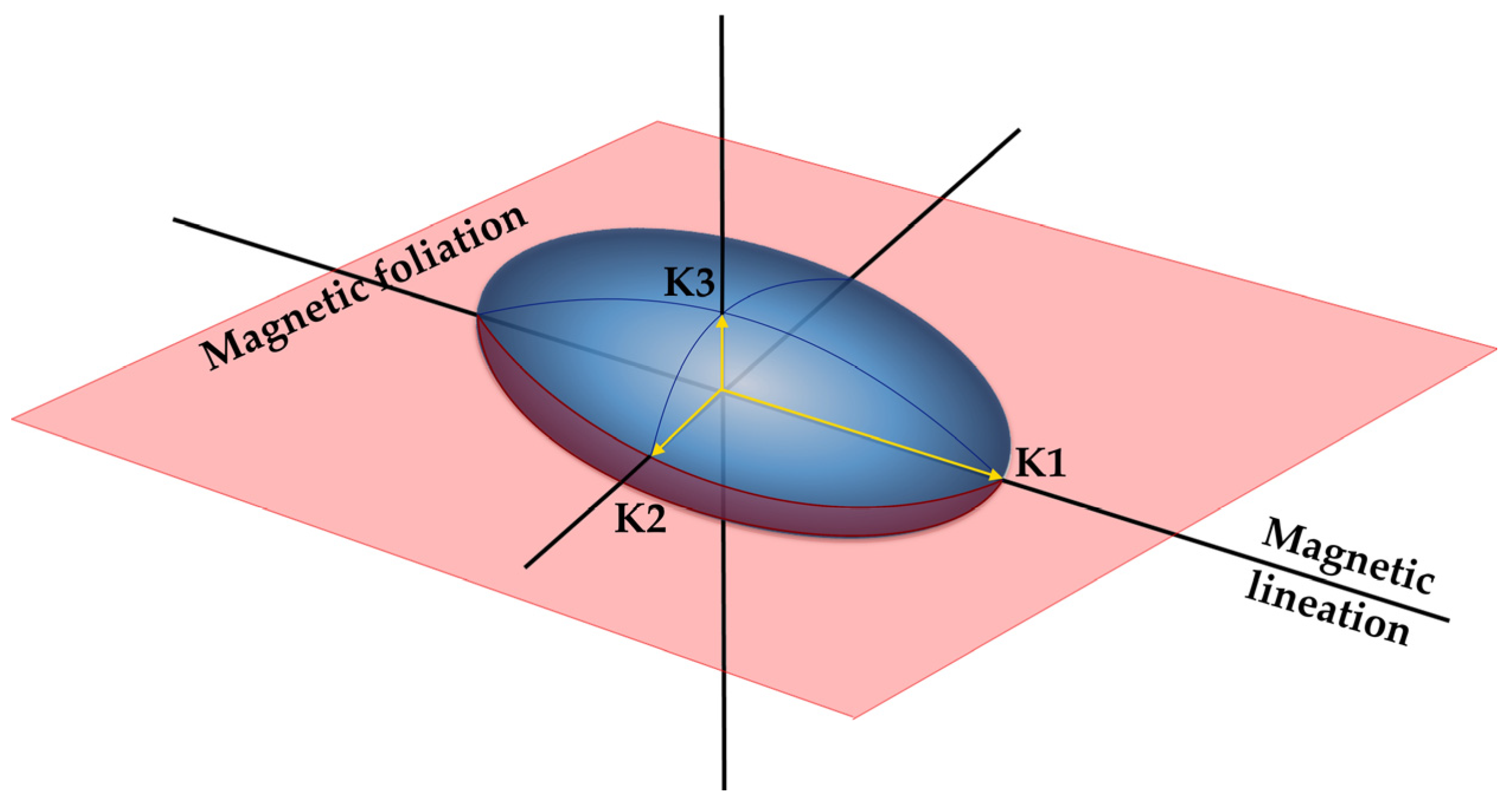

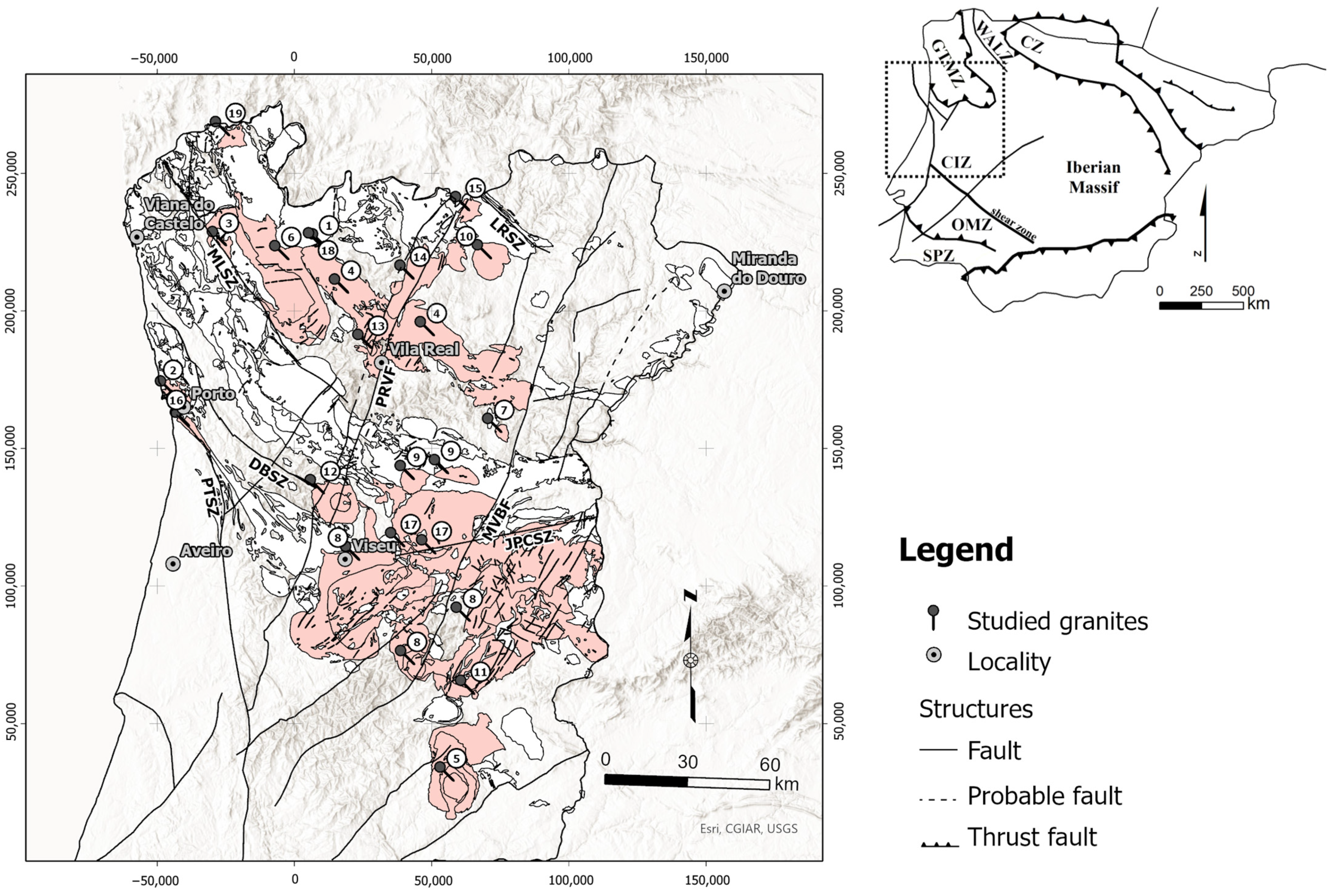



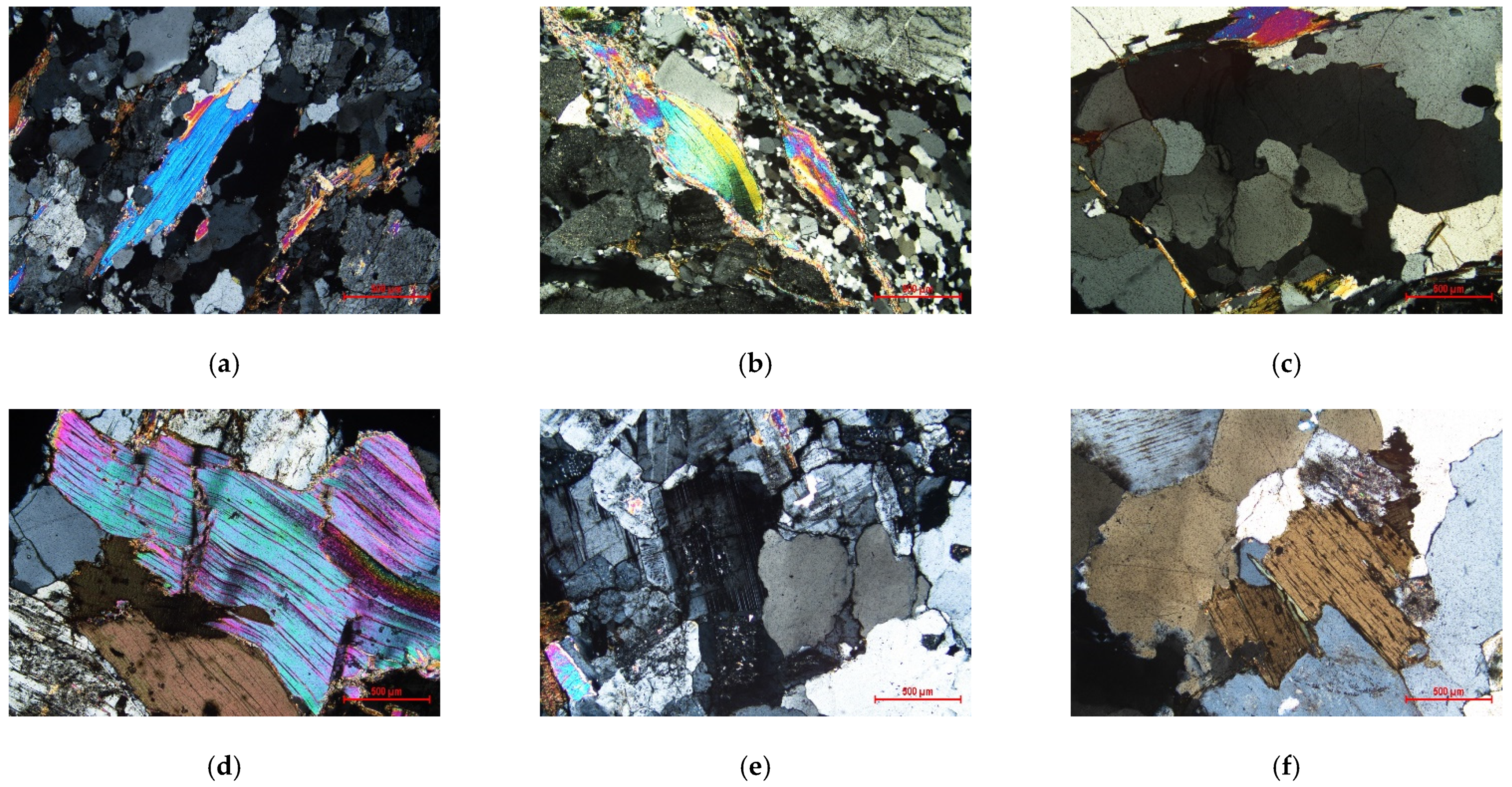

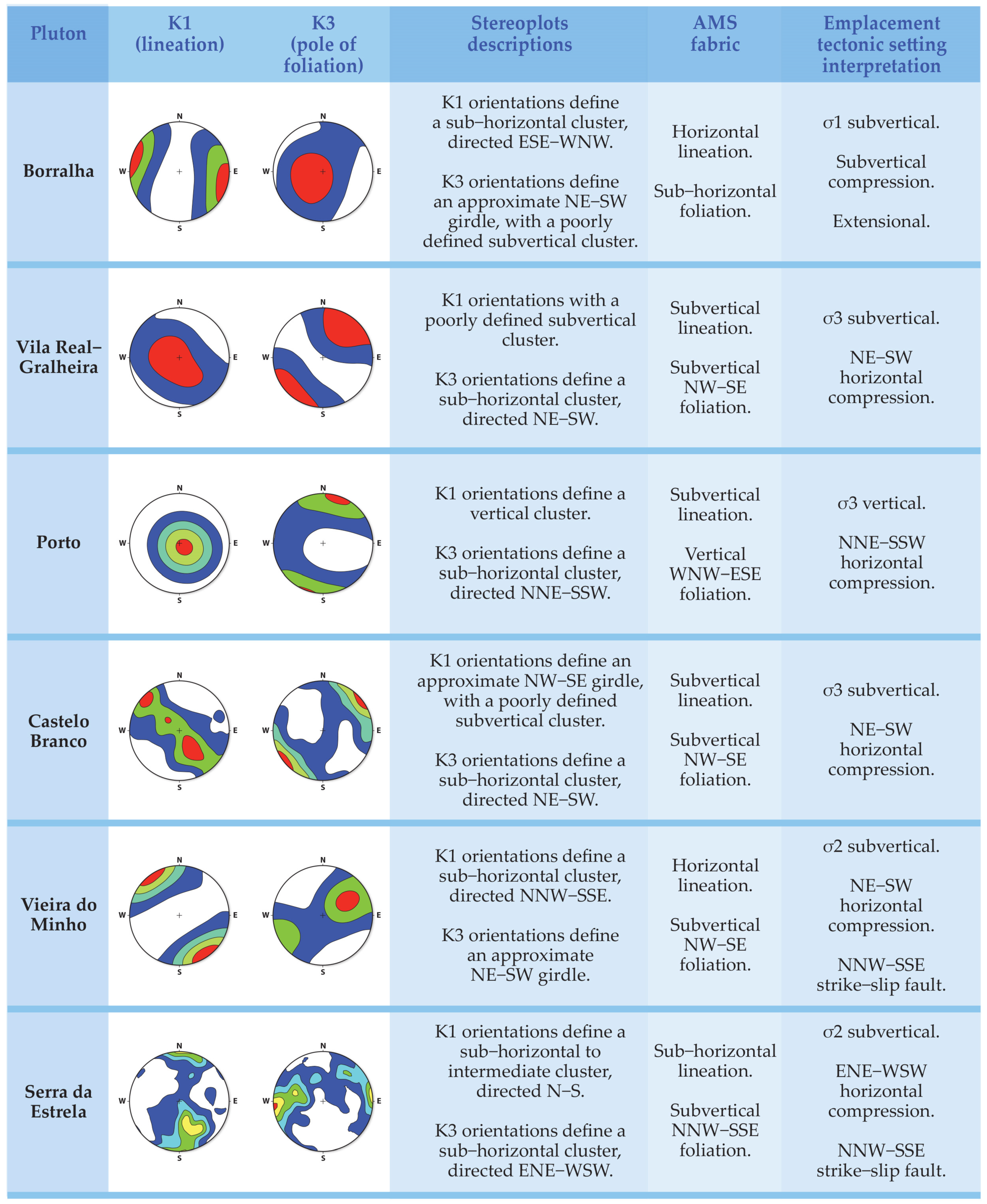
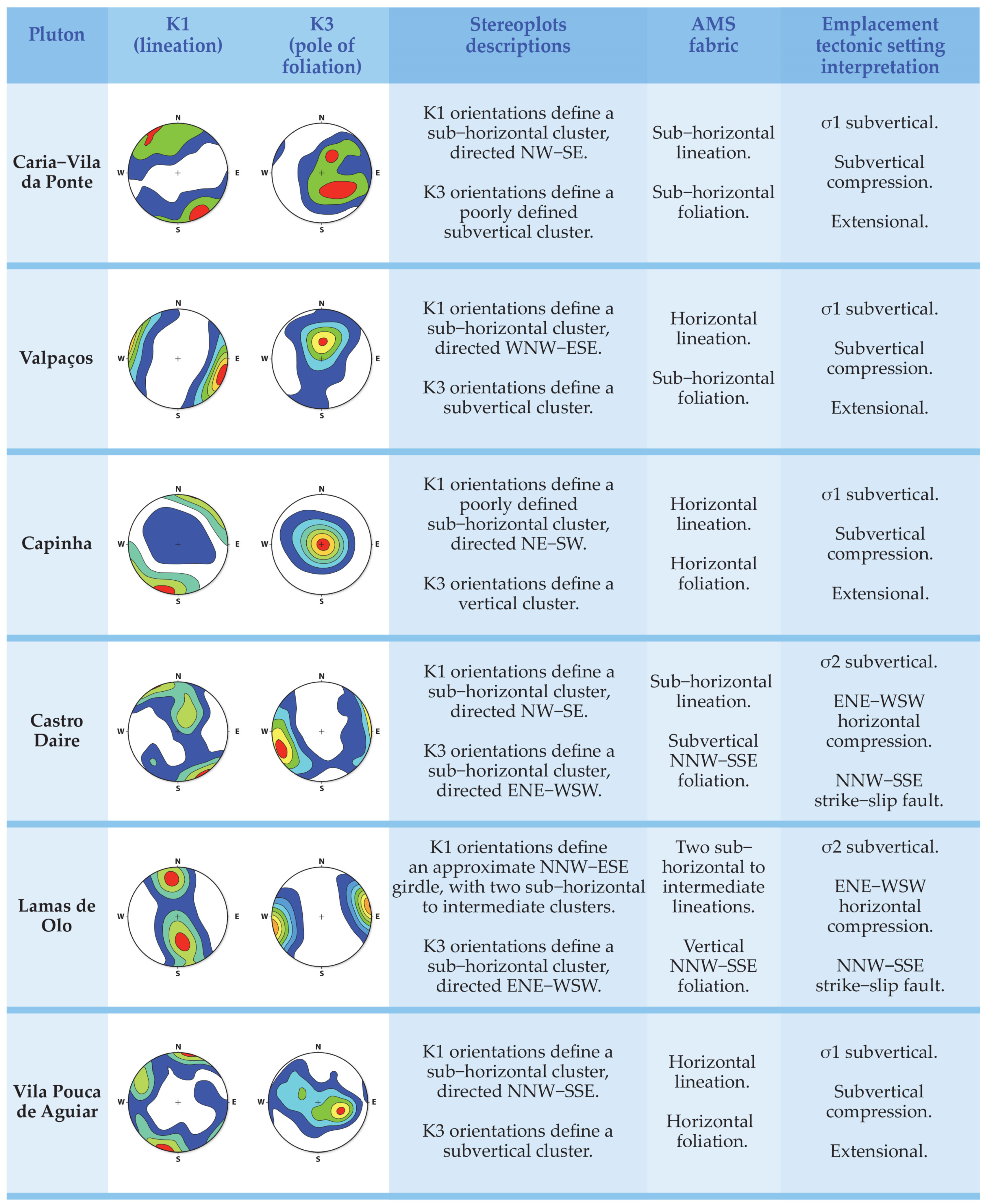


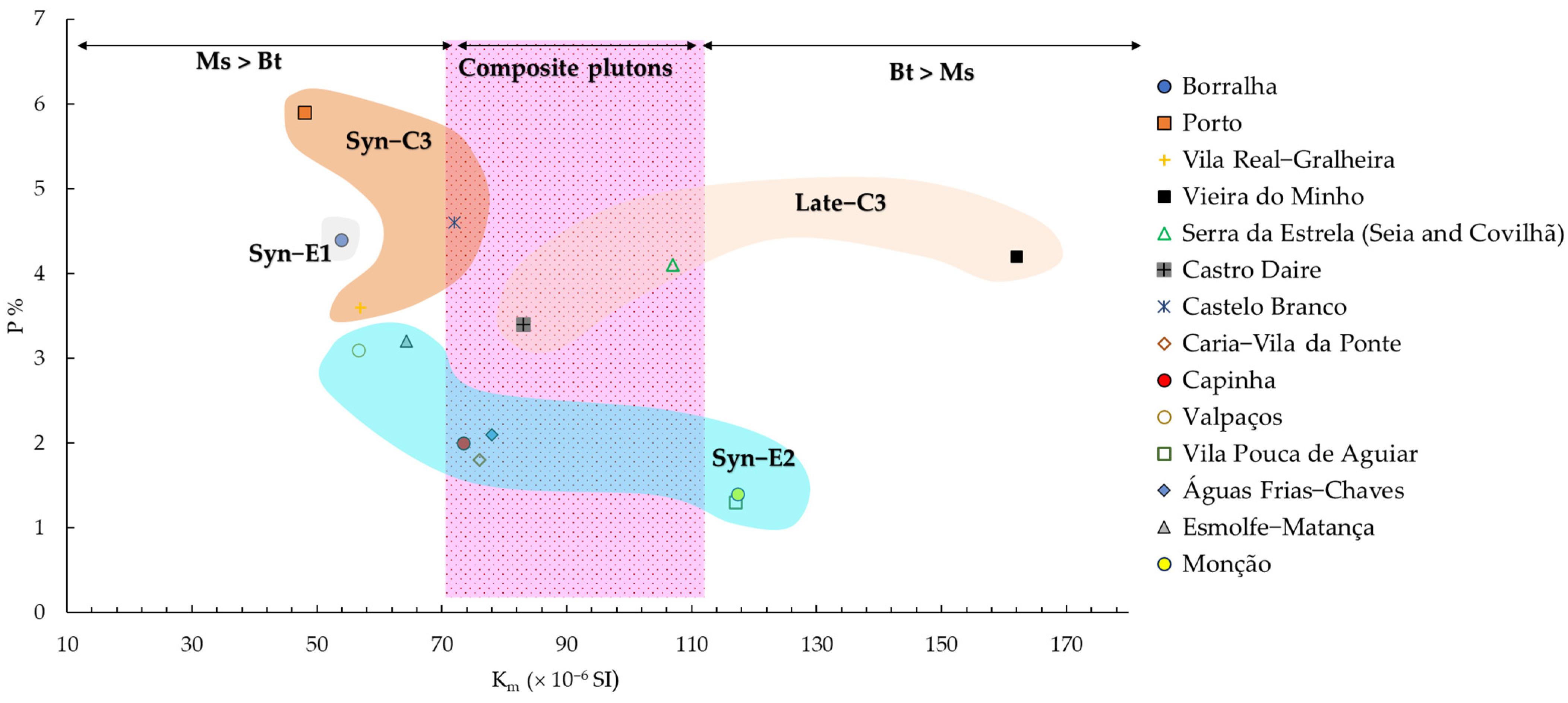
| Pluton | Granites | Age (Ma) | Mineralogy/Texture | References |
|---|---|---|---|---|
| Borralha | Borralha | 320 * | Medium-to-coarse-grained porphyritic biotite granite | [63,64] |
| S. Mamede | S. Mamede | 310 * | Medium-grained two-mica granite | [19] |
| Vila Verde | Medium-to-coarse-grained two-mica granite | |||
| Vila Real-Gralheira | Vila Real | 311 ± 1 | Medium-to-coarse-grained two-mica granite | [9,65] |
| Minheu-Lagoa | Medium-grained porphyritic two-mica granite | |||
| Gralheira | Medium-to-coarse-grained two-mica granite | |||
| Porto | Porto | 311 ± 7 | Medium-grained porphyritic two-mica granite | [9,66] |
| Castelo Branco | Alcains | 310 ± 1 | Porphyritic two-mica granite | [9,67] |
| Castelo Branco | Coarse-grained porphyritic monzogranite | |||
| Vieira do Minho | Vieira do Minho | 310 ± 2 | Coarse-grained porphyritic monzogranite | [68] |
| Moreira de Rei | 307 ± 3.5 | Medium-grained porphyritic monzogranite | ||
| Freixo de Numão | Freixo de Numão | 306 ± 2 | Medium-to-coarse-grained porphyritic two-mica granite | [64,69,70] |
| Frei Tomé | Fine-grained two-mica granite | |||
| Serra da Estrela | Seia | 304.1 ± 2.9 | Coarse-grained porphyritic biotite granites | [71,72] |
| Covilhã | ||||
| Caria-Vila da Ponte | Caria | 301.2 ± 1.2 | Medium-grained porphyritic biotite granite | [12,73] |
| Vila da Ponte | Medium-to-coarse-grained porphyritic biotite granite | |||
| Valpaços | Valpaços | 305 ± 17 | Medium-to-coarse-grained porphyritic muscovite-biotite granite | [70,74] |
| Lagoas | Fine-grained muscovite granite | |||
| Capinha | Capinha | 301 ± 3 | Medium-grained two-mica porphyritic granite | [64,75] |
| Castro de Aire | Calde | 294.1 ± 3.5 | Coarse-grained porphyritic biotite granites | [72,76] |
| Alva | Fine-grained two-mica granite | |||
| Lamas de Olo | Lamas de Olo | 297.19 ± 0.73 | Medium-to-coarse-grained porphyritic biotite granite | [13,18,77,78] |
| Alto dos Cabeços | Medium-to-fine-grained porphyritic biotite granite | |||
| Barragem | Fine-to-medium-grained biotite porphyritic leucogranite | |||
| Vila Pouca de Aguiar | Pedras Salgadas | 297 ± 14 | Medium-to-fine-grained porphyritic biotite granite | [5,79] |
| Vila Pouca de Aguiar | 298 ± 9.1 | Medium-to-coarse-grained porphyritic monzogranite | ||
| Águas Frias-Chaves | Águas Frias | 299 ± 3 | Coarse-grained porphyritic biotite granite | [5] |
| Sto. António de Monforte | Medium-grained two-mica granite | |||
| Lavadores-Madalena | Madalena | 298 ± 11 | Medium-to-coarse-grained porphyritic biotite granite | [80,81] |
| Lavadores | Medium-grained porphyritic biotite granite | |||
| Esmolfe-Matança | Esmolfe-Matança | 298 ± 11 to 298 ± 13 | Medium-grained porphyritic biotite granite | [77,82] |
| Penedos | Penedos | 298 * | Medium-grained leucogranite with garnet | [34,63,82] |
| Monção | Monção | 296 ± 3 | Coarse-grained porphyritic biotite granite | [83] |
| Pluton | Km (×10−6 SI) | Km (×10−6 SI) | P% | P% | K1d | K1i | K1 95% c.a. | Magnetic Lineation | K3d | K3i | K3 95% c.a. | Magnetic Foliation | |
|---|---|---|---|---|---|---|---|---|---|---|---|---|---|
| Borralha (n = 7) | 53.9 | 25.8 | 4.4 | 1.8 | 101 | 5 | 5 | 5°/N101° | 242 | 69 | 3 | N152°, 21°NE | |
| S. Mamede (n = 8) | 84.2 | 35.4 | 4.7 | 1.12 | 338 | 13 | 23 | 13°/N338° | 16 | 27 | 9 | N106°, 63°SW | |
| Vila Real-Gralheira (n = 20) | 57.2 | 1.5 | 3.6 | 0.5 | 224 | 78 | 10 | 78°/N224° | 38 | 12 | 4 | N128°, 78°SW | |
| Porto (n = 6) | 48.7 | 3.9 | 5.9 | 4.9 | 128 | 79 | n.a | 79°/N128° | 13 | 6 | n.a | N103°, 84°SW | |
| Castelo Branco (n = 84) | 71.6 | 28.4 | 4.6 | 2.0 | 137 | 56 | 25 | 56°/N137° | 51 | 2 | 11 | N141°, 88°SW | |
| Vieira do Minho (n = 13) | 161.6 | 37.8 | 4.2 | 0.9 | 147 | 1 | 20 | 1°/N147° | 61 | 27 | 13 | N151°, 63°SW | |
| Freixo de Numão (n = 40) | 123.9 | 23.8 | 2.6 | 2.0 | 112 | 36 | n.a. | 36°/N112° | 12 | 37 | n.a. | N102°, 53°SW | |
| Serra da Estrela (Seia and Covilhã) (n = 201) | 107.0 | 47.5 | 4.1 | 1.1 | 173 | 33 | 43 | 33°/N173° | 267 | 17 | 18 | N177°, 73°NE | |
| Caria-Vila da Ponte (n = 80) | 76.0 | 15.9 | 1.8 | 0.5 | 340 | 10 | 15 | 10°/N340° | 110 | 62 | 11 | N20°, 28°NW | |
| Valpaços (n = 34) | 56.7 | 10.1 | 3.1 | 0.8 | 110 | 4 | 11 | 4°/N110° | 5 | 63 | 5 | N95°, 27°S | |
| Capinha (n = 30) | 73.4 | 12.3 | 2.0 | 1.3 | 208 | 8 | 10 | 8°/N208° | 319 | 87 | 3 | N59°, 3°SE | |
| Castro Daire (n = 105) | 83.0 | 2.9 | 3.4 | 0.9 | 354 | 22 | 46 | 22°/N354° | 253 | 12 | 19 | N163°, 78°NE | |
| Lamas de Olo (n = 48) | 1719.0 | 6350.6 | 5.1 | 2.4 | 169 | 28 | 30 | 28°/N169° | 258 | 2 | 14 | N168°, 88°NE | |
| Vila Pouca de Aguiar (n = 105) | 117.2 | 40.7 | 1.3 | 0.6 | 359 | 1 | 14 | 1°/N359° | 129 | 83 | 11 | N39°, 7°NW | |
| Águas Frias-Chaves (n = 13) | 78.1 | 22.9 | 2.1 | 1.3 | 296 | 7 | 15 | 7°/N296° | 181 | 80 | 6 | N91°, 10°N | |
| Lavadores-Madalena (n = 14) | Lavadores | 10,436.1 | 2983.6 | 18.4 | 4.9 | 219 | 78 | 12 | 78°/N219° | 17 | 12 | 9 | N107°, 78°SW |
| Madalena | 98 | 8 | 11 | 8°/N98° | 4 | 16 | 8 | N94°, 74°SW | |||||
| Esmolfe-Matança (n = 59) | 64.4 | 10.3 | 3.2 | 3.7 | 330 | 6 | 8 | 6°/N330° | 110 | 87 | 3 | N20°, 3°NW | |
| Penedos (n = 6) | 30.4 | 7.0 | 1.9 | 2.0 | 352 | 44 | 13 | 4°/N352° | 62 | 36 | 6 | N152°, 51°SW | |
| Monção (n = 3) | 117.4 | 34.3 | 1.4 | 1.5 | 260 | 12 | n.a | 12°/N3260° | 153 | 57 | n.a | N63°, 33°NW |
Disclaimer/Publisher’s Note: The statements, opinions and data contained in all publications are solely those of the individual author(s) and contributor(s) and not of MDPI and/or the editor(s). MDPI and/or the editor(s) disclaim responsibility for any injury to people or property resulting from any ideas, methods, instructions or products referred to in the content. |
© 2024 by the authors. Licensee MDPI, Basel, Switzerland. This article is an open access article distributed under the terms and conditions of the Creative Commons Attribution (CC BY) license (https://creativecommons.org/licenses/by/4.0/).
Share and Cite
Sant’Ovaia, H.; Cruz, C.; Gonçalves, A.; Nogueira, P.; Noronha, F. Deciphering Iberian Variscan Orogen Magmatism Using the Anisotropy of Magnetic Susceptibility from Granites. Minerals 2024, 14, 309. https://doi.org/10.3390/min14030309
Sant’Ovaia H, Cruz C, Gonçalves A, Nogueira P, Noronha F. Deciphering Iberian Variscan Orogen Magmatism Using the Anisotropy of Magnetic Susceptibility from Granites. Minerals. 2024; 14(3):309. https://doi.org/10.3390/min14030309
Chicago/Turabian StyleSant’Ovaia, Helena, Cláudia Cruz, Ana Gonçalves, Pedro Nogueira, and Fernando Noronha. 2024. "Deciphering Iberian Variscan Orogen Magmatism Using the Anisotropy of Magnetic Susceptibility from Granites" Minerals 14, no. 3: 309. https://doi.org/10.3390/min14030309







